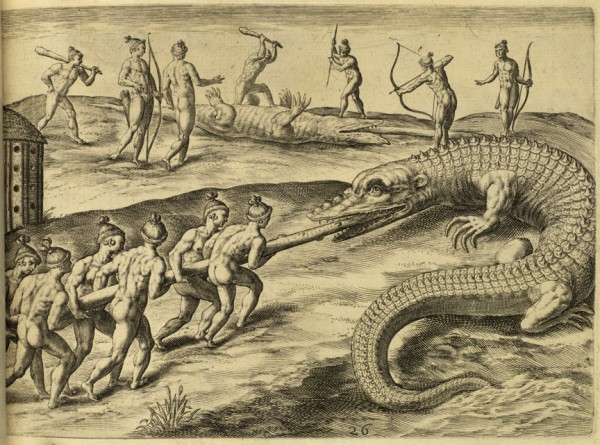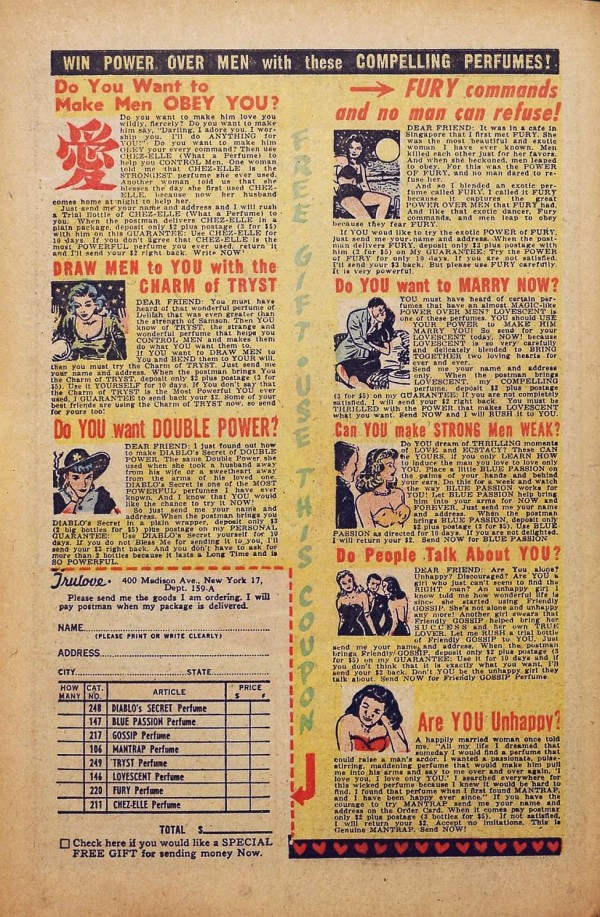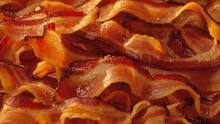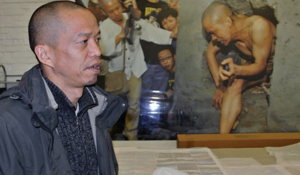May 2014
May 14, 2014
Name That List, #23
What is this a list of? The answer is below in extended.- Ed Delahanty, a baseball player
- A rubber ball nicknamed the "Plunge-O-Sphere"
- A schooner called "Michigan" occupied by a buffalo, two small bears, two raccoons, and a dog.
- A cat named Iagara
- A turtle named Sonny
More in extended >>
Posted By: Alex - Wed May 14, 2014 -
Comments (4)
Category: Name That List
Theodor de Bry

[Click to enlarge]
I love the almost-human arms and legs on this enormous alligator, which is being attacked, ostensibly, by Native Americans, as depicted by 16th-century artist Theodor de Bry.
"The verisimilitude of many of de Bry's illustrations is questionable; not least because he never crossed the Atlantic. "
Posted By: Paul - Wed May 14, 2014 -
Comments (10)
Category: Animals, Art, Europe, North America, Sixteenth Century
May 13, 2014
The Snogometer
Posted By: Paul - Tue May 13, 2014 -
Comments (5)
Category: Sexuality, Chindogu, 1960s
Nonesuch, the Cat-Dog

In 1937, the Journal of Heredity (vol 28, no. 3). published an article about an unusual kitten that looked very much like a dog. The kitten was called "Nonesuch."
From the very moment of its birth, which was about twelve hours after the rest of the litter, the nonesuch was surprisingly independent in its actions. It was born with its eyes open, and was able to crawl a little — two characteristics quite unknown to new-born kittens.
The nonesuch acts both like a cat and a dog. While it makes a noise like a cat, it sniffs its food like a dog. Nothing delights the nonesuch more than gnawing a bone in a very dog-like manner.
However, although Nonesuch looked like a dog, she was definitely a cat, which she proved by giving birth to a litter of kittens a year later.
Posted By: Alex - Tue May 13, 2014 -
Comments (6)
Category: Animals, Cats, Dogs, 1930s
May 12, 2014
The Century Camera
Here's the latest project from artist Jonathon Keats, whose work has been posted about on WU quite a few times before (such as here and here). He writes:Some more details:
Participants will be free to hide their cameras anywhere in Berlin that they deem worthy of long-term clandestine observation, and they'll be expected to keep the location secret into old age. At that stage, the participant will reveal the location to a child, who in turn will be responsible for keeping the secret into adulthood, so that 100 years from now one person in the world will know where to retrieve each camera. Whoever brings a camera back to Team Titanic in 100 years will collect the 10-euro deposit, and the 100-year photo will be extracted from the sealed pinhole canister for inclusion in a special Team Titanic exhibition. The exhibit is scheduled to open on 16 May 2114.
Full details at teamtitanic.com.


Posted By: Alex - Mon May 12, 2014 -
Comments (6)
Category: Photography and Photographers
Win Power Over Men!

Original ad here.
Posted By: Paul - Mon May 12, 2014 -
Comments (8)
Category: Advertising, Comics, Perfume and Other Scents, 1950s, Women
May 11, 2014
WHISKEY BACON

Pigs raised on feed containing Templeton Rye Distillery's spent rye mash. The ultimate in flavor infusion!
Posted By: Alex - Sun May 11, 2014 -
Comments (6)
Category: Bacon
Uncle Tom and Little Eva
Not a single stereotype about African-Americans left unexplored!
Posted By: Paul - Sun May 11, 2014 -
Comments (2)
Category: Ethnic Groupings, Racism, Regionalism, Stereotypes and Cliches, Cartoons, 1930s
The Pain Artist

- Having one of his ribs removed so that he could wear it as a necklace.
- Having a doctor cut a one meter gash down the side of his body, without anesthesia.
- Encasing himself in a cube of quick-setting concrete for 24 hours.
- Trying to "cut a river in half" by suspending himself above it from a crane while holding a knife in the water, as blood dripped from cuts in his arms.
- Painting the fingernails and toenails of 10 mannequins with his own blood.
- Staring at 10,000 watt bulbs to damage his eyesight
- Burning his clothes while wearing them.
[via The Rakyat Post]
Posted By: Alex - Sun May 11, 2014 -
Comments (6)
Category: Performance Art
May 10, 2014
Joan Jonas
More on the "artist" here.
Still doing her thing in 2014!
Posted By: Paul - Sat May 10, 2014 -
Comments (6)
Category: Ineptness, Crudity, Talentlessness, Kitsch, and Bad Art, Avant Garde, Performance Art
| Get WU Posts by Email | |
|---|---|

| Who We Are |
|---|
| Alex Boese Alex is the creator and curator of the Museum of Hoaxes. He's also the author of various weird, non-fiction books such as Elephants on Acid. Paul Di Filippo Paul has been paid to put weird ideas into fictional form for over thirty years, in his career as a noted science fiction writer. He has recently begun blogging on many curious topics with three fellow writers at The Inferior 4+1. Chuck Shepherd Chuck is the purveyor of News of the Weird, the syndicated column which for decades has set the gold-standard for reporting on oddities and the bizarre. Our banner was drawn by the legendary underground cartoonist Rick Altergott. Contact Us |


